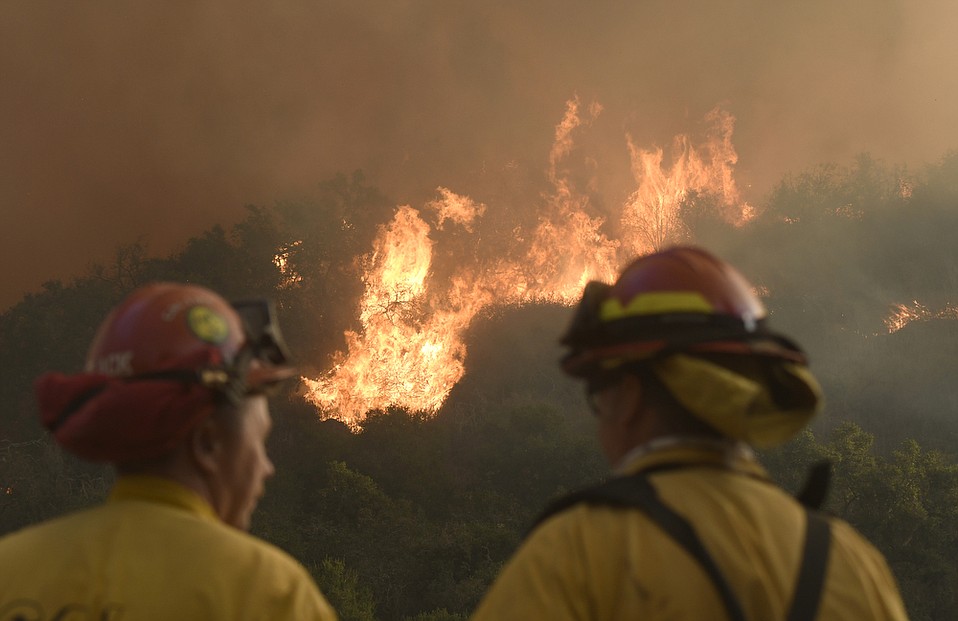Investigators Say Edison Power Lines Sparked Thomas Fire
Utility Pushes Back, Claiming Officials Mishandled and Ignored Evidence

Ventura fire investigators have determined that Southern California Edison power lines slapping together in high winds ignited the 2017 Thomas Fire, which burned for more than a month across Ventura and Santa Barbara counties, consuming more than 280,000 acres of terrain and destroying hundreds of family homes.
“A high wind event caused the power lines to come into contact with each other, creating an electrical arc,” the Ventura County Fire Department said in a press statement. “The electrical arc deposited hot, burning or molten material onto the ground, in a receptive fuel bed, causing the fire. The common term for this situation is called ‘line slap,’ and the power line in question is owned by Southern California Edison.”
The 71-page report published Wednesday describes the fire’s starting point as Anlauf Canyon near Thomas Aquinas College. Firefighters received the first 9-1-1 call at 6:23 p.m. on December 4, 2017. The report also makes note of a second wildfire that began approximately an hour later at 7:30 p.m. near Koenigstein Road. It was treated as a separate incident and named the Koenigstein Fire. By 1 a.m., however, the two fires had merged and were thereafter referred to as the Thomas Fire.
While the Ventura County Fire Department is still drafting its investigative report on the Koenigstein Fire, explained spokesperson Captain Stan Ziegler, Southern California Edison has already suggested its equipment may have been responsible for starting the second blaze. Edison stated last October that based on its own probe it “believes that its equipment was associated with the Koenigstein ignition.”
Ventura authorities, who conducted their investigation alongside Cal Fire, the Santa Barbara County Fire Department, and the U.S. Forest Service, have forwarded their latest findings to the state attorney general’s office and recommended that the utility face charges of involuntary manslaughter, negligence, and unlawfully causing a fire causing great bodily injury.
Southern California Edison (SCE) wasted no time refuting the report. Just hours after it went public, the utility issued its own statement accusing Ventura County Fire Department (VCFD) investigators of both mishandling evidence and ignoring key pieces of information provided by Edison. “SCE has evidence that the ignition at Anlauf Canyon started at least 12 minutes prior to any issue involving SCE’s system and at least 15 minutes prior to the start time indicated by VCFD in its report,” the company said, referencing radar data of smoke plumes in the area. “SCE provided this evidence to CAL FIRE and VCFD investigators; however, the report does not suggest this evidence was considered.”
Edison claimed Ventura officials failed to preserve physical evidence from the scene as well as video footage from Ventura’s own webcams. “SCE understands that Ventura County had approximately 12 cameras in the vicinity, but VCFD recently revealed it had failed to preserve video footage from 11 of those cameras,” the utility said. “While SCE greatly admires the first responders and members of the firefighting community who bravely responded to the Thomas Fire, the company is disappointed that VCFD’s investigators failed to preserve critical evidence and seemed to ignore best practices in conducting their origin and cause analysis.”
The debate will continue in court, where Edison faces more than $1.3 billion in insurance claims filed by Thomas Fire victims. Two people were killed by the blaze ― a Ventura woman evacuating her home and a firefighter on the front lines. The company may also be on the hook for another $400 million in claims filed by 1/9 Debris Flow victims. The Thomas Fire stripped the hillsides above Montecito of all vegetation and gave rise to the late-night cascade of mud and boulders that claimed 23 lives.
PG&E, Edison’s counterpart in Northern California, is facing its own bevy of lawsuits that claim the utility’s equipment sparked multiple deadly wildfires. PG&E has threatened to declare bankruptcy should it be held liable. Both companies have since initiated programs that preemptively shut off power during extreme fire weather.



